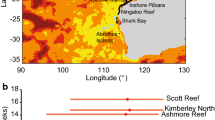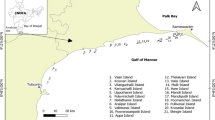Abstract
The southern Great Barrier Reef (GBR), a region that rarely experiences cyclones, was impacted by tropical cyclone (TC) Hamish in March 2009. We documented on-reef physical and habitat conditions before, during and after the cyclone at One Tree Reef (OTR) using data from environmental sensor instrumentation and benthic surveys. Over 5 years of monitoring, ocean mooring data revealed that OTR experienced large swells (4–8 m) of short duration (10–20 min) not associated with a cyclone in the area. These swells may have contributed to the physical disturbance of benthic biota and decline in coral cover recorded prior to and after TC Hamish. During the cyclone, OTR sustained southeasterly gale force winds (>61.2 km h−1) for 18.5 h and swells >6 m in height for 4 h. Benthic surveys of exposed sites documented a 20% drop in live coral cover, 30% increase in filamentous algae cover and the presence of dislodged corals and rubble after the storm. Leeward sites were largely unaffected by the cyclone. Benthic cover did not change in the lagoon sites. Significant rubble movement and infill of the lagoon occurred. Two years after the cyclone, algal cover remained high and laminar corals had not recovered. Total coral cover at impacted sites had continued to decline. Environmental conditions and habitat surveys supported Puotinen’s (Int J Geogr Inf Sci 21:97–120, 2007) model for cyclone conditions that cause reef destruction. While TC Hamish had a major impact on the reef, change in benthic cover over several years was due to multiple stressors. This on-reef scale integration of physical and biological data provided a rare opportunity to assess impacts of a major storm and other disturbances, showing the importance of considering multiple stressors (short-lived and sustained) in assessing change to reef habitats.







Similar content being viewed by others
References
Ardhuin F, Chapron B, Collard F (2009) Observation of swell dissipation across oceans. Geophys Res Let 36:1–5
Booth DJ, Beretta GA (2002) Changes in a fish assemblage after a coral bleaching event. Mar Ecol Prog Ser 245:205–212
Coles SL, Brown EK (2007) Twenty-five years of change in coral coverage on a hurricane impacted reef in Hawai’i: the importance of recruitment. Coral Reefs 26:705–717
Connell JH, Hughes TP, Wallace CC (1997) A 30-year study of coral abundance, recruitment, and disturbance at several scales in space and time. Ecol Monogr 67:461–488
Done TJ (1992) Phase shifts in coral reef communities and their ecological significance. Hydrobiol 247:121–132
Emslie MJ, Cheal AJ, Sweatman H, Delean S (2008) Recovery from disturbance of coral and reef fish communities on the Great Barrier Reef. Aust Mar Ecol Prog Ser 371:177–190
Fabricius K, De’ath G, Puotinen ML, Done T, Cooper TF, Burgess SC (2008) Disturbance gradients on inshore and offshore coral reefs caused by severe tropical cyclone. Limnol Oceanogr 53:690–704
Foster KA, Foster G, Tourenq C, Shuriqi MK (2011) Shifts in coral community structures following cyclone and red tide disturbances within the Gulf of Oman (United Arab Emirates). Mar Biol 158:955–968
Gardner TA, Cote IM, Gill JA, Grant A, Watkinson AR (2005) Hurricanes and Caribbean coral reefs: Impacts, recovery patterns, and role in long-term decline. Ecology 86:174–184
Guillemot N, Chabanet P, Le Pape O (2010) Cyclone effects on coral reef habitats in New Caledonia (South Pacific). Coral Reefs 29:445–453
Halford A (2004) Resilience to large-scale disturbance in coral and fish assemblages on the GBR. Ecology 85:1892–1905
Hoegh-Guldberg O (2011) Coral reef ecosystems and anthropogenic climate change. Reg Environ Change 11:S215–S227
Hoegh-Guldberg O, Mumby PJ, Hooten AJ, Steneck RS, Greenfield P, Gomez E, Harvell CD, Sale PF, Edwards AJ, Caldeira K, Knowlton N, Eakin CM, Iglesias-Proeto R, Muthida N, Bradbury RH, Dubi A, Hatziolos ME (2007) Coral reefs under rapid climate change and ocean acidification. Science 318:1737–1742
Hughes TP, Connell JH (1999) Multiple stressors on coral reefs: a long-term perspective. Limnol Oceanogr 44:932–940
Kingsford MJ (2009) Contrasting patterns of reef utilization and recruitment of coral trout (Plectropomus leopardus) and snapper (Lutjanus carponotatus) at One Tree Island, southern Great Barrier Reef. Coral Reefs 28:251–264
Kingsford MJ, Battershill CN (eds) (1998) Procedures for establishing a study. Studying temperate marine environments: a handbook for ecologists. Canterbury University Press, Christchurch, pp 29–48
Knutson TR, McBride JL, Chan J, Emanuel K, Holland G, Landsea C, Held I, Kossin JP, Srivastava AK, Sugi M (2010) Tropical cyclones and climate change. Nat Geosci 3:157–163
Lough J (2007) Chapter 2 climate and climate change on the great barrier reef. In: Johnson J, Marshall P (eds) Climate change and the great barrier reef: a vulnerability assessment great barrier reef marine park, Authority and Australian Greenhouse Office, Australia
Lourensz RS (1981) Tropical cyclones in the Australian region. July 1909 to June 1980. Australian Government Printing Service, Canberra
Madin JS (2011) Climate change: increasing storm activity. In: Hopley D (ed) Encyclopedia of modern coral reefs. Springer, The Netherlands, pp 218–221
Madin JS, O’Donnell MJ, Connolly SR (2008) Climate-mediated mechanical changes to post-disturbance coral assemblages. Biol Lett 4:490–493
Marshall JF, Davies PJ (1982) Internal structure and Holocene evolution of One Tree Reef, southern Great Barrier Reef. Coral Reefs 1:21–28
Massel SR, Done TJ (1993) Effects of cyclone waves on massive coral assemblages on the Great Barrier Reef, southern Great Barrier Reef. Coral Reefs 12:153–166
Nadon MO, Stirling G (2006) Field and simulation analyses of visual menthods for sampling coral cover. Coral Reefs 25:177–185
Puotinen ML (2007) Modelling the risk of cyclone wave damage to coral reefs using GIS: a case study of the Great Barrier Reef, 1969–2003. Int J Geogr Inf Sci 21:97–120
Sale PF, Douglas WA, Doherty PJ (1984) Choice of microhabitats by coral reef fishes at settlement. Coral Reefs 3:91–99
Underwood A (1997) Experiments in ecology: their logical design and interpretation using analysis of variance. Cambridge University Press, Cambridge
van Woesik R, Ayling AM, Mapstone B (1991) Impact of tropical cyclone “Ivor” on the Great Barrier Reef. Aust J Coast Res 7:551–553
Veron JEN (2000) Corals of the World. Australian Institute of Marine Sciences, Townsville
Young IR (1989) Wave transformation over coral reefs. J Geophys Res 94:9779–9789
Acknowledgments
This study used data from GBROOS a facility of the Integrated Marine Observing System (IMOS) jointly funded by the Australian Government National Collaborative Research Infrastructure Strategy and the Queensland State Government. We thank staff of One Tree Island Research Station, University of Sydney, Jennifer Reiffel and Russell Graham. Funding was provided by the ARC Centre of Excellence for Coral Reef Studies. Thanks to Mark O’Callaghan, Rebecca Lawton and Natalie Soars for assistance.
Author information
Authors and Affiliations
Corresponding author
Additional information
Communicated by F. Bulleri.
Rights and permissions
About this article
Cite this article
Woolsey, E., Bainbridge, S.J., Kingsford, M.J. et al. Impacts of cyclone Hamish at One Tree Reef: integrating environmental and benthic habitat data. Mar Biol 159, 793–803 (2012). https://doi.org/10.1007/s00227-011-1855-8
Received:
Accepted:
Published:
Issue Date:
DOI: https://doi.org/10.1007/s00227-011-1855-8




